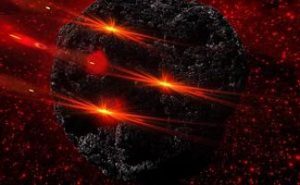Asteroid mining could one day be a vast new way to gather scarce materials if the financial and technological obstacles can be overcome. Asteroids are lumps of metals, rock and dust, sometimes laced with ice and tar, which are the cosmic “leftovers” from the solar system’s formation about 4.5 billion years ago. There are hundreds of thousands of them, ranging in size from a few yards to hundreds of miles across. Small asteroids are much more numerous than large ones, but even a little, house-sized asteroid should contain metals possibly worth millions of dollars.
Over the last hundred years, the human population has exploded from about 1.5 billion to more than seven billion, driving an ever-increasing demand for resources. To satisfy civilization’s appetite, communities have expanded recycling efforts while mine operators must explore frontiers to seek out new deposits, opening mines miles underground or even at the bottom of the ocean. However, there are only so many places on earth from which these precious resources can be mined.
Asteroid mining is the exploitation of raw materials from asteroids and other minor planets, including near-Earth objects. Minerals and volatiles could be mined from an asteroid or spent comet, then used in space for in-situ utilization (e.g. construction materials and rocket propellant) or taken back to Earth. 
These include gold, iridium, silver, osmium, palladium, platinum, rhenium, rhodium, ruthenium and tungsten for transport back to Earth; iron, cobalt, manganese, molybdenum, nickel, aluminum, and titanium for construction; water and oxygen to sustain astronauts; as well as hydrogen, ammonia, and oxygen for use as rocket propellant.
A university project to investigate mining in space, which uses a vision system to map the particles thrown up by a drill, is underway in Poland.
The DREAM project – standing for Drilling Experiment for Asteroid Mining – is part of the international REXUS program (Rocket Experiments for University Students), which is sponsored by the European Space Agency (ESA), the Swedish National Space Board (SNSB) and the German Aerospace Center (DLR). The program involves sending experiments prepared by student groups from all over Europe to an altitude of 100 km via a sounding rocket to carry out measurements and then analyze the results.
Being able to correctly map the asteroid will require precision from all areas. From the robotic side, ensuring complete control over the instruments, to the precision lens mounted in the cameras that is sending the data back to the in-flight computers. By choosing UKA, you can have complete confidence knowing that your precise lens design will be completed with the highest accuracy, as our entire process is done in-house.
The experiments main objective is to investigate the drilling process in different space conditions. A number of physical parameters will be measured – such as force, temperature and torque. The teams goal is to determine what challenges lie ahead for mining in space.
Universe Kogaku designs and manufactures optical lenses for multiple applications including mining, security, high tech and electronics. We stock 1000’s of standard lens assemblies and can custom design a solution for scanners, CCTV, CCD/CMOS, medical imaging, surveillance systems, machine vision and night vision systems.